Fat-tire e-bikes are not just about aesthetics—they’re built with purpose. The oversized rubber adds unmatched stability and traction, letting you tackle everything from snowy trails to sandy beaches, loose gravel, and rugged off-road tracks. These bikes aren’t for sticking to the pavement; they’re for riders who need a rig that can handle unpredictable terrain without batting an eye. In this guide to the best fat tire e-bikes, we’re breaking down the standout models of 2025, highlighting what makes each one capable of going where other bikes can’t.
The added width of those 4-inch or wider tires isn’t just for show—it’s about better float and grip on surfaces where traditional tires bog down or slip out. Fat electric bikes are designed to take on a range of conditions that most bikes wouldn’t touch, whether you’re commuting through slush-filled city streets, exploring remote snow-packed backroads, or cruising along stretches of soft sand. Paired with powerful motors and torque-heavy setups, the best fat electric fat bikes are built to keep you rolling through the most challenging environments with ease.
This year’s lineup is all about refinement—brands are dialing in everything from frame geometry to battery placement to maximize comfort and control, even on the sketchiest surfaces. Whether you’re riding for fun, practical utility, or just looking to expand your boundaries, there’s a fat-tire e-bike on this list that fits the bill. Let’s dig into the models that are making the biggest impact in 2025, with insights into what makes them a solid choice for tackling your kind of terrain.
Best Fat Tire E-Bikes for 2025
- Rad Power Bikes Radster Trail
- Aventon Aventure.2
- Lectric XPeak 2.0
- Specialized Globe Haul ST
- Rad Power Bikes RadRunner 3 Plus
- Ride1Up Portola
- Lectric XP 3.0
- Ride1Up Revv1
- Mokwheel Basalt
- Velotric Discover
- Mokwheel Obsidian
Best Overall (Mid-Fat 2.5 to 3.5”)
Rad Power Bikes Radster Trail
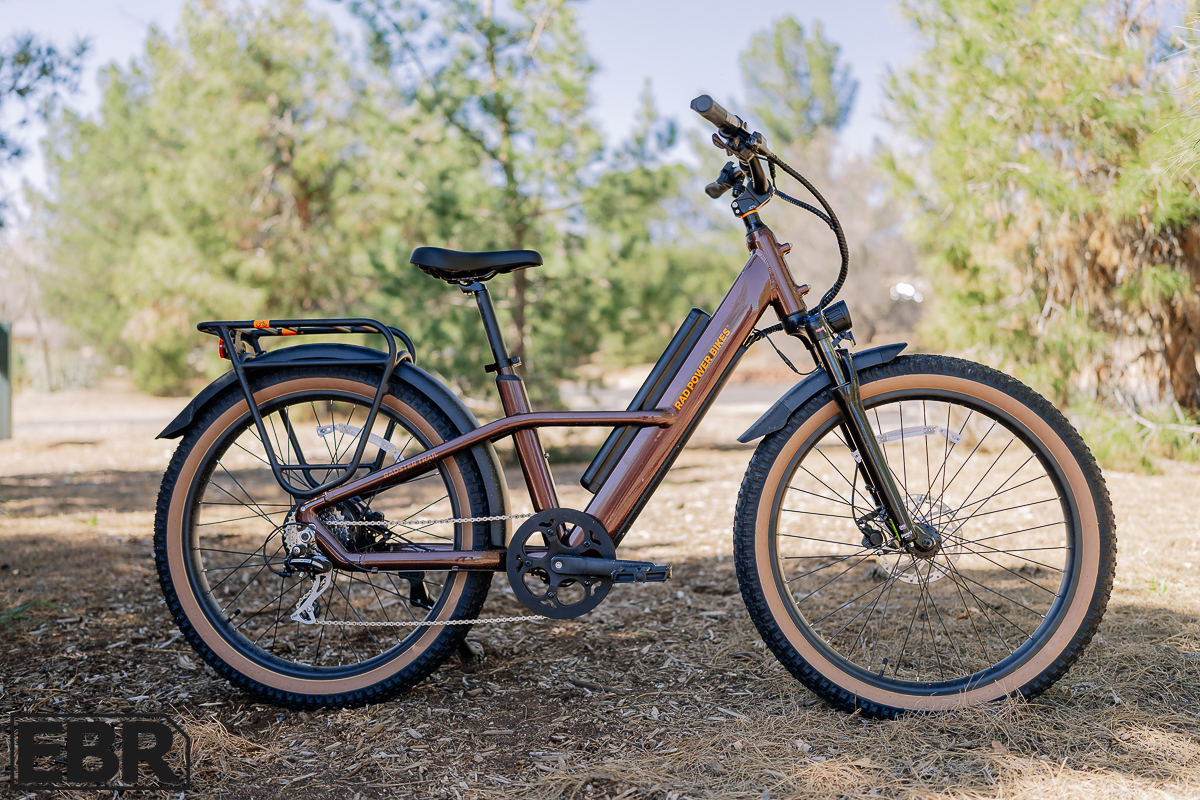
Highlights
- The 750W hub motor cranks out 100Nm of torque, giving this bike serious climbing power for tackling hills with ease.
- Cushy 3-inch-wide tires provide a smooth ride with confident traction and great handling on varied terrain.
- The updated, oversized display is easy to read and features a security fob for added peace of mind.
- The sturdy mid-step frame is not only easy to mount but also stiff enough to handle heavier loads without flex.
- With a 290-lb max rider weight and 370-lb total capacity, it’s perfect for grocery hauls or carrying extra gear.
Areas for Improvement
- The battery charge level could be more precise if displayed as a percentage rather than a bar graph.
The Rad Power Bikes Radster Trail takes the crown as our “Best Mid-Fat Tire E-Bike” of 2025, and for good reason. With its 27.5″ x 3″ tires, this bike strikes the perfect balance—wide enough to feel planted on dirt and gravel but still smooth enough for road rides. If you’re splitting your time between pavement and trails, the Radster Trail hits the sweet spot.
The 750W hub motor cranks out a hefty 100Nm of torque, making it a solid hill-climber and quick off the line. It’s paired with a 720Wh battery, which Rad says can hit up to 65 miles, but, through real-world tests I got closer to 75 miles—plenty for long commutes or full-day rides. The hydraulic disc brakes with 180mm rotors give you solid stopping power, even when you’re riding loaded. And speaking of loads, the bike’s 370-lb total weight capacity (290 lbs for the rider) makes it perfect for running errands or hauling extra gear.
Comfort is dialed in with an 80mm Suntour suspension fork that takes the sting out of rougher roads, paired with upright geometry and a mid-step frame that’s both stiff and easy to mount. The new color display is a nice upgrade—clear, easy to read, and unlocked with a security fob for added convenience.
If there’s a downside, I’m not a fan of battery life displayed in the ‘bar’ icon, I’d rather have a more specific percentage in numbers. The Radster Trail comes in two frame sizes, a regular and large, fitting a total range from 4’ 11” to 6’ 4”. Plus, the adjustable handlebars and seat post help you dial in a more precise fit. At $2,199, the Radster Trail gives reliable performance, practical features, and a smooth ride for those who want a mid-fat e-bike that’s built for both city streets and light off-road adventures.
For a full rundown of this bike, read our Rad Power Radster Trail review.
Best Overall Fat Tire: 3.5″ to 5”
Aventon Aventure.2
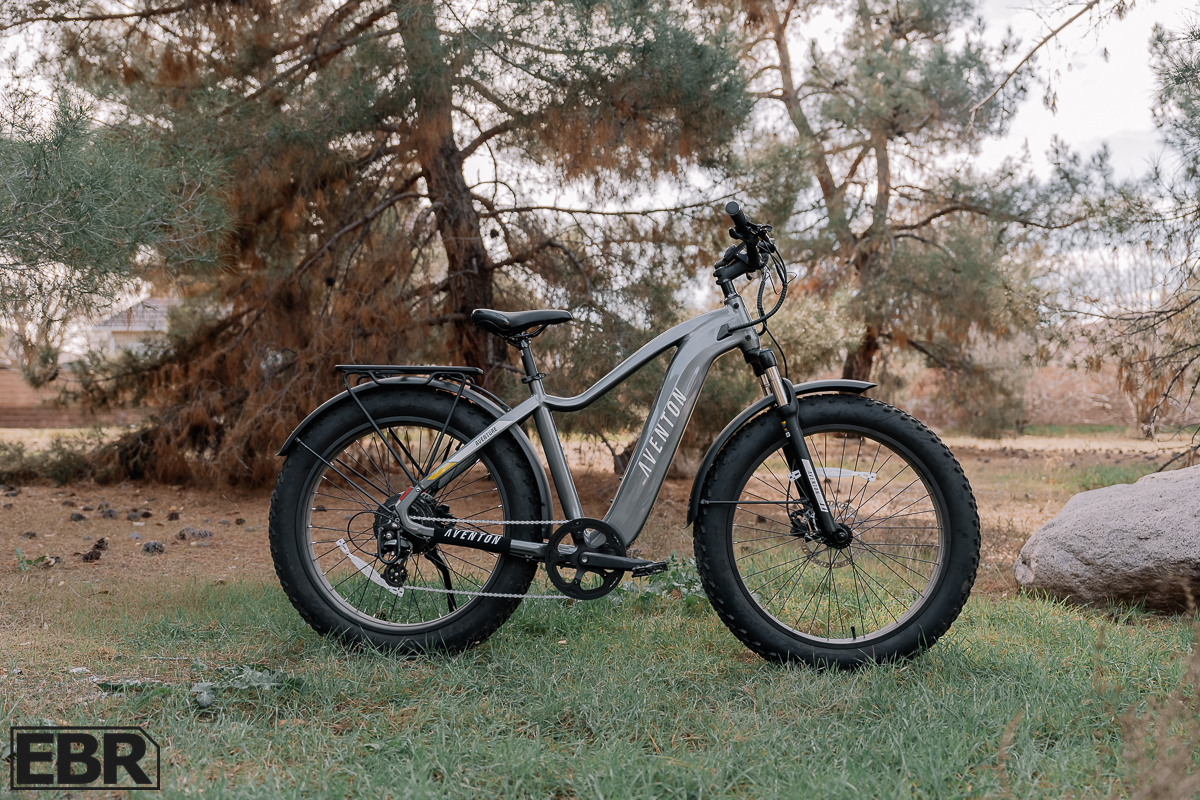
Highlights
- The 750W brushless hub motor paired with a torque sensor delivers snappy acceleration and an ultra-responsive ride feel.
- Strong motor power and smart gearing make this bike a legit Class 3 performer, hitting those top speeds with ease.
- Tektro hydraulic disc brakes with 180mm rotors provide confident stopping power and control, even when cornering hard
- Aventon’s smartphone app lets you tweak performance settings and track your rides—handy for staying dialed in.
- With a hefty 400-lb total weight capacity, it’s ready to handle both the rider and extra cargo without a sweat.
Areas for Improvement
- The Shimano Altus drivetrain is solid but feels a bit less refined than the Acera setup on the previous Aventure model.
The Aventon Aventure.2 takes the crown for “Best Overall Classic Fat Tire E-Bike” in 2025, and for good reason. It checks all the boxes: great performance, solid features, and easy availability. With 4-inch-wide tires, it’s ready to crush sand, snow, gravel, or pavement—your go-anywhere, do-anything ride.
The 750W hub motor paired with a torque sensor makes for snappy acceleration and smooth, natural pedal assist. Unlike cadence sensors, the torque sensor adjusts power based on your effort, making the ride feel responsive and dialed. As a legit Class 3 performer, it easily hits 28 mph when you need speed.
Tektro hydraulic disc brakes with 180mm rotors handle stopping duties with confidence, whether you’re cornering or hauling gear. With a 400-lb total weight capacity, it’s not just about fun rides—it’s built for errands, commuting, or weekend trips. Bonus: the Aventon app lets you track rides and fine-tune your setup.
The Shimano Altus drivetrain isn’t fancy, but it’s a workhorse that still gets the job done. All in all, the Aventure.2 is a well-rounded fat tire e-bike that brings capability, comfort, and versatility to whatever terrain you tackle, all at a fair price in today’s inflated market.
For all the specific details, check out our full Aventon Aventure.2 review.
Best Value Fat Bike
Lectric XPeak 2.0
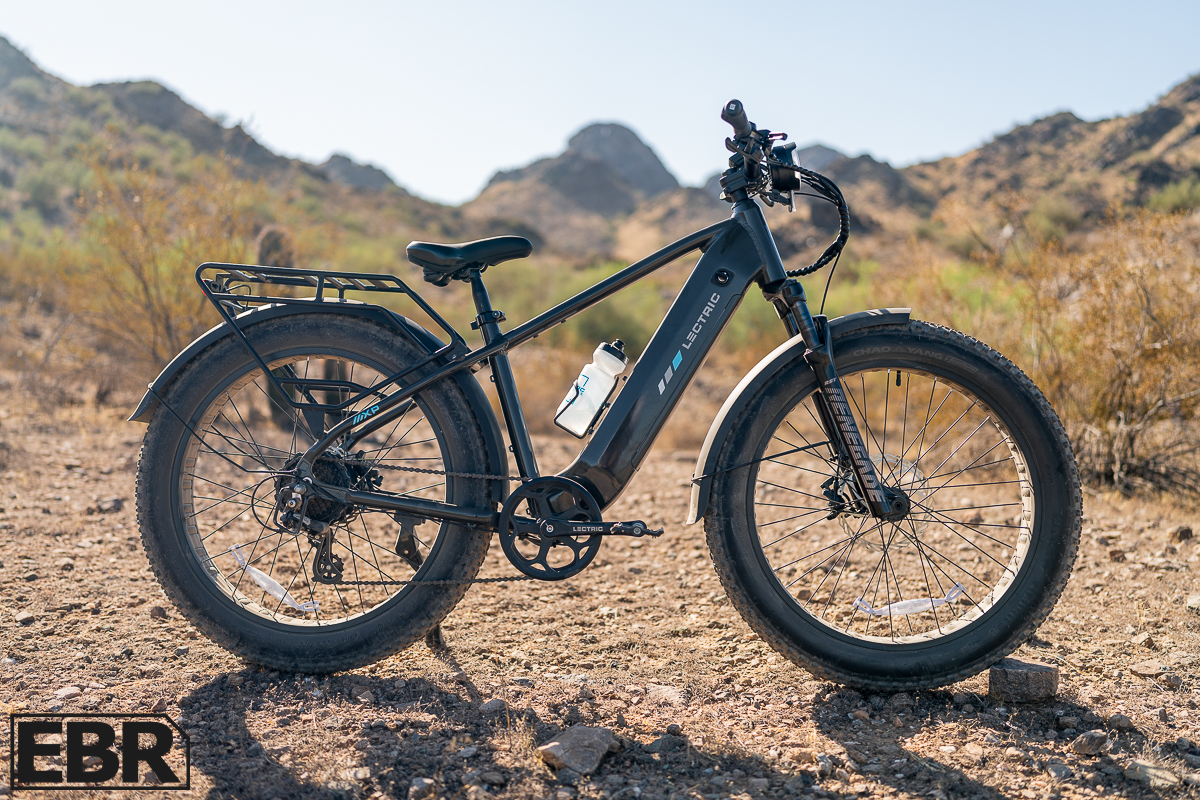
Highlights
- The redesigned frame not only looks sleek but also offers stiffer, more responsive handling for a sharper ride.
- Battery capacity gets a boost with the 720Wh standard pack, and there’s an optional 960Wh upgrade for those who want even more range.
- The upgraded under-the-bar trigger shifter feels modern and intuitive, replacing the clunkier over-the-bar style from earlier versions.
- A new color display with IP65 water and dust resistance adds durability, and the USB charging port is a handy touch.
- The trusty RST Renegade suspension fork sticks around, keeping the ride smooth over rougher terrain.
- An improved Shimano 8-speed drivetrain with an 11-34t cassette provides better gear range and reliability.
Areas for Improvement
- Both the High-Step and Step-Through versions are available in only one frame size, which could limit fit for some riders.
The Lectric XPeak 2.0 earns the title of “Best Value Fat Tire E-Bike” for 2025 by delivering premium upgrades without a premium price. At $1,399, it packs serious performance and features that are hard to beat. With a redesigned frame, it’s not just better looking—it’s stiffer and more responsive, giving the bike sharper handling whether you’re on trails or city streets.
The 750W motor and 720Wh battery offer solid power and range, and there’s even an optional 960Wh upgrade for riders who want to push it further. New for the 2.0 is a torque sensor, which makes pedal-assist feel smooth and natural, giving the ride a snappier, more refined feel compared to the old cadence sensor setup. The Shimano 8-speed drivetrain with an 11-34t cassette adds better gear range, making climbs and cruising easier, while the under-the-bar trigger shifter feels intuitive and modern.
Comfort stays dialed with the trusty RST Renegade fork, soaking up bumps on rough terrain, and the IP65-rated color display adds durability with a USB charging port for convenience. The only downside? Both the High-Step and Step-Through versions come in one frame size, which might not work for all riders.
For riders looking to maximize performance and features without blowing up your budget, the Lectric XPeak 2.0 delivers. With power, range, and thoughtful upgrades, it’s the ultimate value-packed fat tire e-bike for tackling a little bit of everything.
Want to learn more? Read the full Lectric XPeak 2 review.
Best Utility Fat Tire Electric Bike
Specialized Globe Haul ST
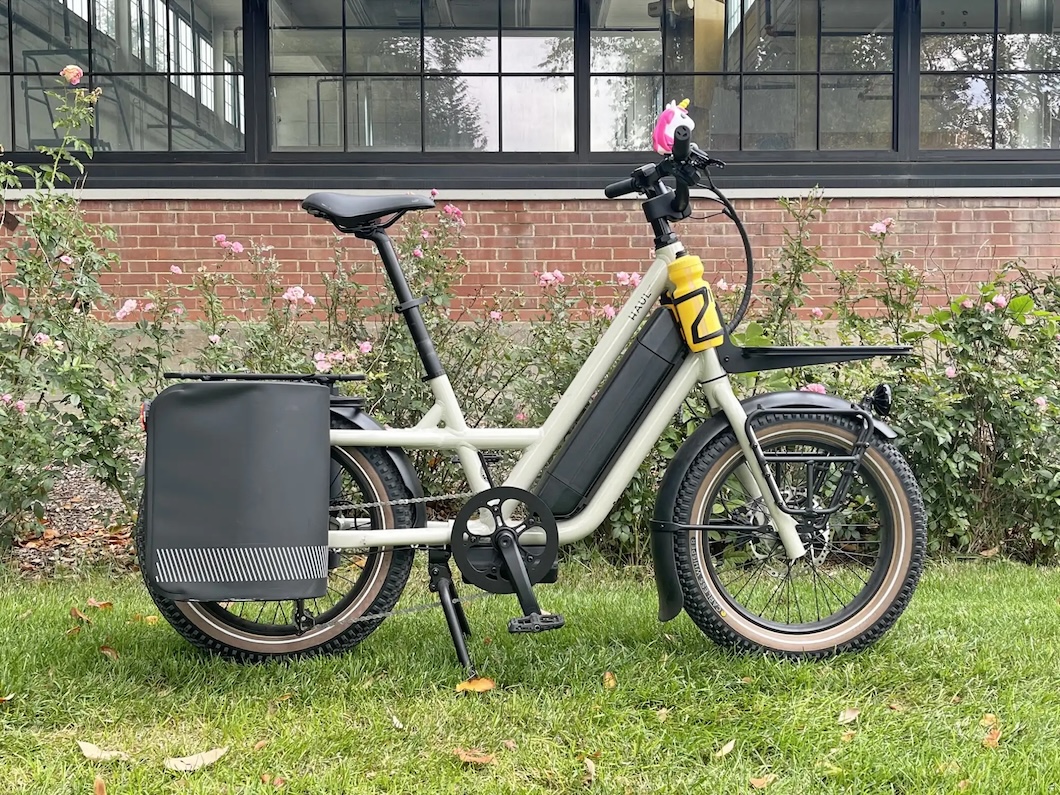
Highlights
- The motor is a blast to ride—super responsive, smashes hill climbs and plenty of speed.
- Highly versatile design fits riders from 4’5″ to 6’4″ with adjustable comfort features and smart geometry.
- The 20″x3.5″ tires keep the handling playful while maintaining a low center of gravity for excellent balance.
- With a 419-lb payload capacity, MIK rack, and pack mounts, it’s built for hauling and customization to suit your needs.
- Pairs with the Globe app for ride customization and tracking.
Areas for Improvement
- The rear rack supports up to 132 lbs but feels a bit short, which might limit its use for carrying a second rider. For more versatility, check out the long-tail Haul option.
The Specialized Globe Haul ST takes the top spot as the “Best Utility Fat Tire Electric Bike” for 2025, thanks to its combination of power, versatility, and hauling capability. This bike is a workhorse disguised as a fun ride. The motor is responsive and quick, making hill climbs a breeze and providing plenty of speed for urban commutes or errands.
The Haul ST is built for versatility, fitting riders from 4’5″ to 6’4″ with its adjustable geometry and comfort features. The 20″ x 3.5″ tires keep the handling playful and nimble, while the low center of gravity adds balance and stability—perfect for carrying heavy loads. Speaking of loads, this bike has a massive 419-lb payload capacity, with a MIK-compatible rear rack and multiple pack mounts that make it easy to customize for hauling groceries, gear, or whatever you need.
The Globe app is another bonus, letting you track rides and fine-tune performance settings for a more personalized experience. The rear rack holds up to 132 lbs, which is great for cargo but might feel cramped for a second rider. If you need more passenger space, Specialized’s long-tail Haul option might be a better fit.
Overall, the Globe Haul ST is the ultimate utility e-bike, combining functionality and fun. Whether you’re commuting, running errands, or hauling gear, this bike gets the job done and keeps the ride enjoyable.
Best Utility Fat Bike (Runner Up)
Rad Power Bikes RadRunner 3 Plus
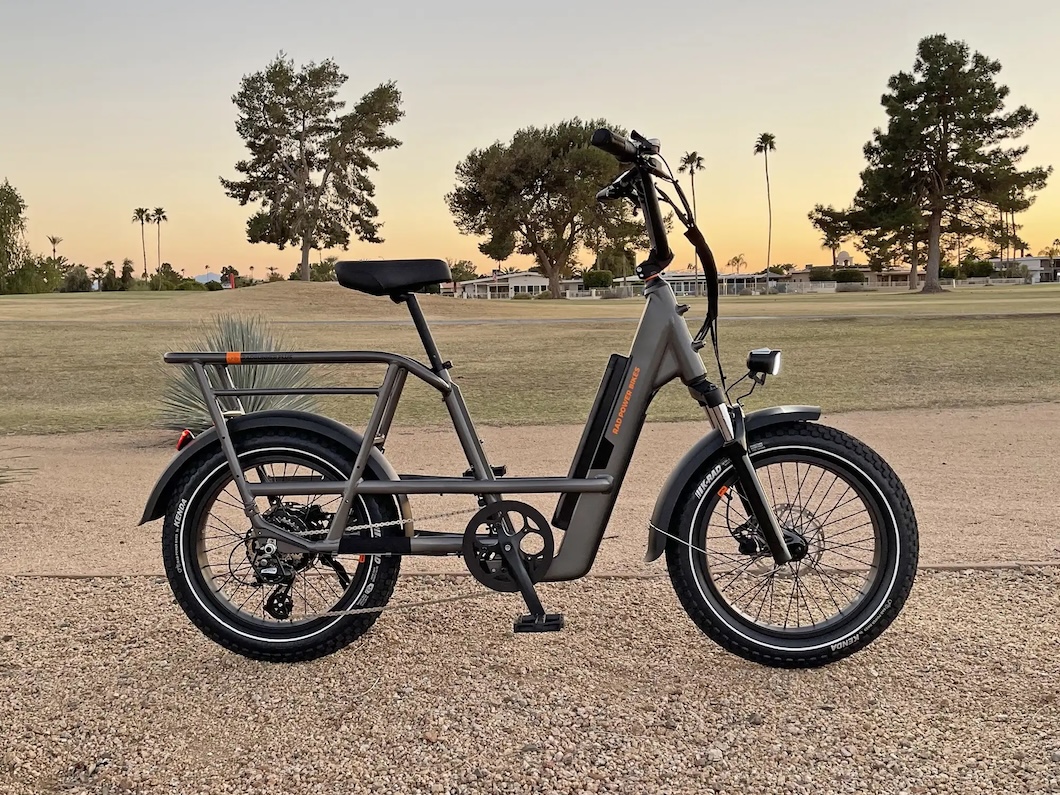
Highlights
- The newer redesigned frame supports up to 350 lbs, with a semi-integrated battery that’s easy to mount and remove—no need to detach the optional locking console.
- Step-thru frame and 20″ wheels make it approachable for petite riders, while adjustable seats and bars fit riders from 4’11” to 6’2″.
- Custom 3.3″ Kenda tires with puncture protection and reflective stripes pair with a suspension fork to smooth out the ride and boost comfort.
- The 60mm suspension fork handles heavy loads with preload adjustment and lockout, plus you can swap in a suspension seat post for even more comfort.
- Rear rack supports 120 lbs and works with Rad’s accessories or a front rack and RadTrailer to haul up to 100 lbs more.
Areas for Improvement
- The motor delivers great power but has a noticeable zipping noise at higher assist levels or throttle, though it’s quieter on lower settings.
- Single frame size feels compact and may be snug for taller riders, but adjustments can help improve the fit.
The Rad Power Bikes RadRunner 3 Plus grabs the “Best Utility Fat Bike (Runner-Up)” spot for 2025. This bike is built to handle just about anything while staying approachable and practical. The redesigned frame supports up to 350 lbs, and the semi-integrated battery is a breeze to pop on and off—even with the optional locking console still attached.
The step-thru frame and 20″ wheels make it super easy to hop on, especially for shorter riders, but the adjustable seat and handlebars let it comfortably fit folks up to 6’2″. The 3.3″ Kenda tires with puncture protection and reflective stripes, combined with a 60mm suspension fork, keep the ride smooth and steady—even when you’re loaded up. Speaking of cargo, the rear rack holds 120 lbs, and you can add a front rack or RadTrailer to haul even more gear.
The motor’s got plenty of punch, but you might hear some zipping noise when you crank up the assist or throttle—it’s quieter on lower settings. The frame’s single size feels compact, which could be snug for taller riders, but the adjustable components help make it work.
All in all, the RadRunner 3 Plus is a versatile, dependable utility bike. Whether you’re commuting, hauling groceries, or just cruising, it’s a solid pick for riders who need a fat tire e-bike that’s up for whatever your task may be.
Get the complete lowdown in our RadRunner 3 Plus review.
Best Folding Fat Tire Electric Bike (and its Under $1000)
Ride1Up Portola
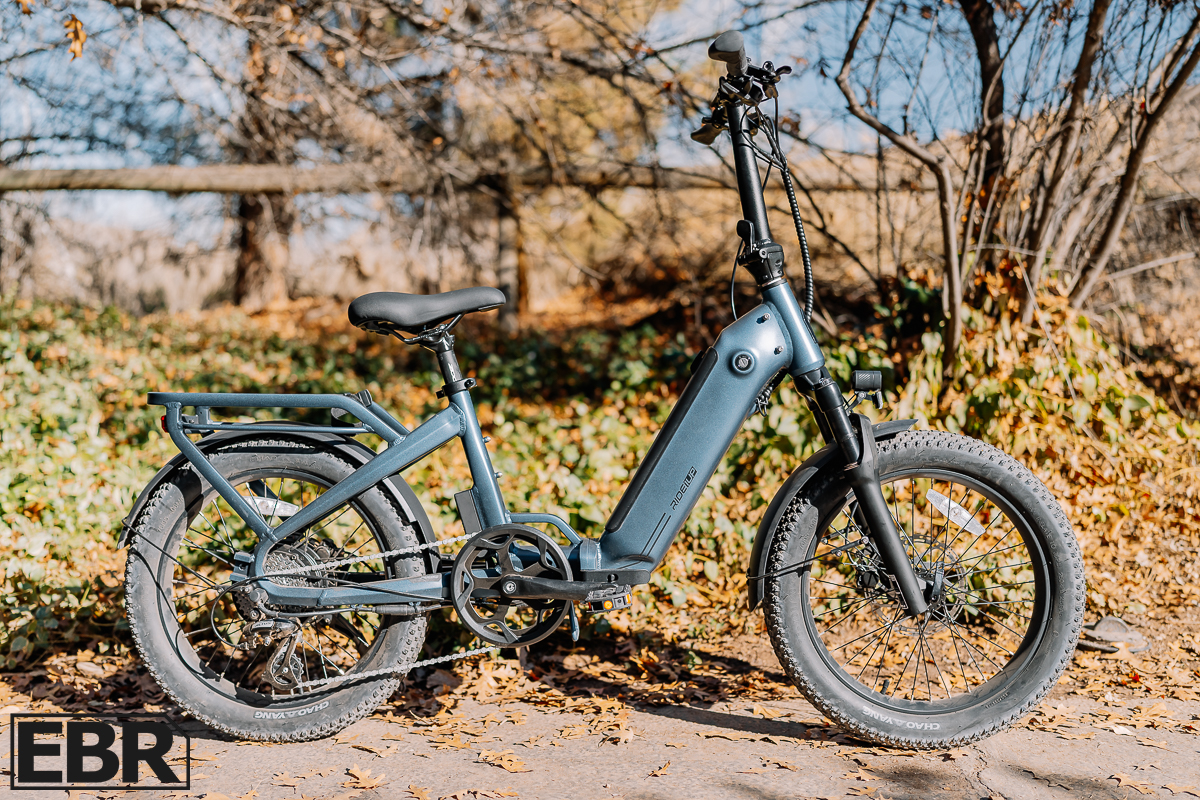
Highlights
- It’s rare to see a $1,000 e-bike with a 750W brushless geared hub motor—seriously impressive at this price point.
- Ride1UP undershot the range, claiming 40 miles, but real-world tests hit just shy of 50 miles—better-than-expected performance.
- The 8-speed Shimano Altus drivetrain gives you more gear range than usual for this price, and the RapidFire shifter makes shifting smooth and easy.
- The 3-inch Chaoyang tires and 80mm suspension fork make for a comfy ride, even when you’re venturing off-road.
- This bike is a legit Class 3 performer—it accelerates easily to 28 mph without ghost pedaling.
- The 24-magnet cadence sensor makes the motor more responsive, giving you quick engagement and added confidence while riding.
Areas for Improvement
- A slightly longer seatpost would improve leg extension for better comfort and pedaling efficiency.
The Ride1Up Portola takes the crown as the “Best Folding Fat Tire Electric Bike” in 2025, delivering performance and value that’s hard to beat in the sub-$1,000 category. With a 750W brushless hub motor, this bike has enough power to handle hills, quick accelerations, and even some light off-road adventures. Plus, Ride1Up underpromised on range—while they claim 40 miles, real-world tests showed closer to 50, which is a pleasant surprise.
The 3-inch Chaoyang tires paired with an 80mm suspension fork keep things smooth and stable, whether you’re on pavement or exploring a bit of gravel. The 8-speed Shimano Altus drivetrain offers more gear range than you’d expect at this price, and the RapidFire shifter makes for quick, easy shifts. With its Class 3 setup, the Portola gets up to 28 mph without any ghost pedaling, so you’re not spinning out trying to keep up with the motor.
The 24-magnet cadence sensor deserves a shoutout, too, for making the pedal-assist feel snappy and responsive. If there’s a nitpick, it’s the seatpost—adding a longer one would make for better leg extension and a more efficient pedal stroke, especially for taller riders.
Overall, the Ride1Up Portola offers a rare mix of affordability, power, and versatility. It’s a compact, folding fat-tire e-bike that punches well above its weight class, making it perfect for commuters, casual riders, or anyone looking for a capable bike that doesn’t break the bank.
For a deeper dive, take a look at our Ride1Up Portola review.
Best Folding Fat Tire e-Bike For RV and Travel
Lectric XP 3.0
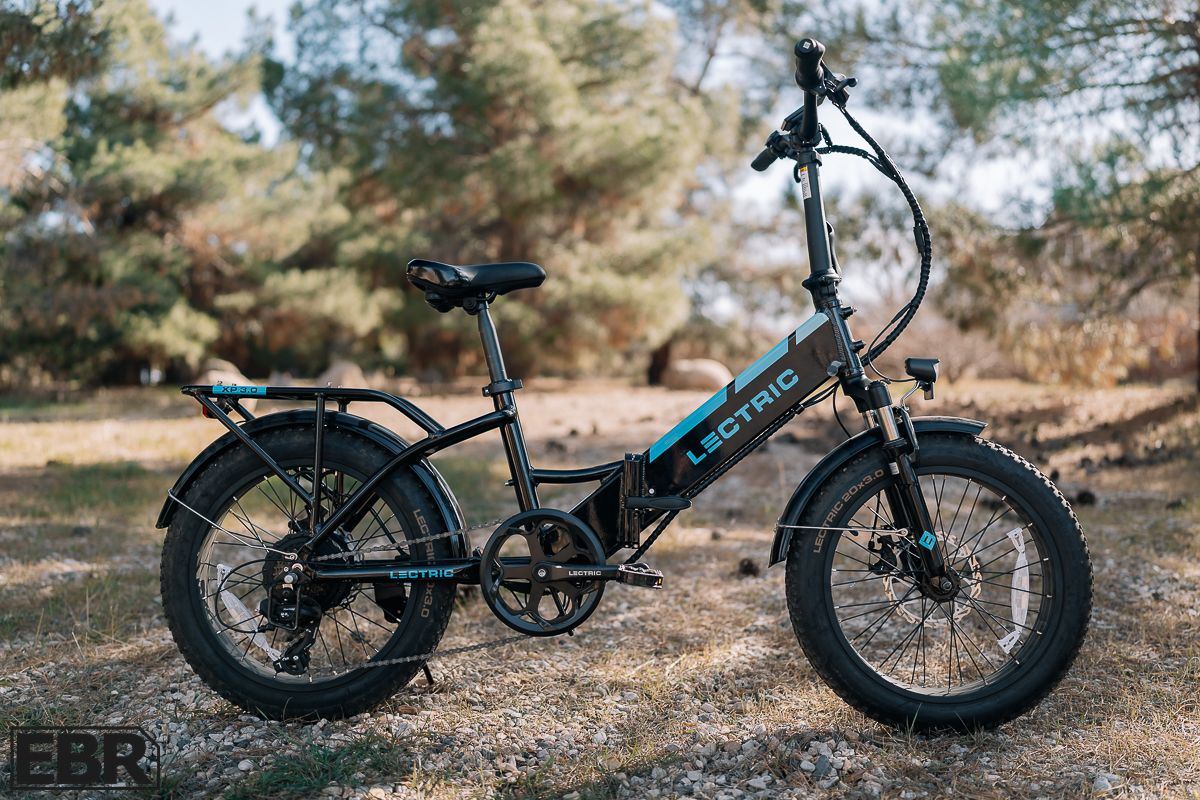
Highlights
- Torque jumped from 35Nm to 55Nm, and peak power hit 1000W, making this bike noticeably more fun and capable to ride.
- Hydraulic disc brakes with upgraded 180mm rotors deliver way better stopping power and control than the previous mechanical setup.
- The new 11-28t freewheel gives the drivetrain the legs to hit Class 3 speeds over 20 mph with ease.
- The rear rack is now integrated into the frame, doubling its weight capacity to 150 lbs—perfect for hauling a kid’s seat or extra cargo.
- Fork travel increased from 40mm to 50mm, taking the edge off bumps and smoothing out rougher rides.
Areas for Improvement
- The battery lock still requires the key to be inserted to ride, and the jiggling key can be a hassle.
- The Shimano Tourney thumb shifter isn’t great—upgrading to a trigger shifter would make shifting smoother and more intuitive.
The Lectric XP 3.0 takes the title of “Best Folding Fat Tire E-Bike for RV and Travel” in 2025, and it’s easy to see why. This little powerhouse combines portability with performance, making it a perfect companion for road trips, RV adventures, or just stashing away when space is tight. With a peak power of 1000W and torque bumped up to 55Nm, it’s got the muscle to handle hills and zippy rides, whether you’re exploring campgrounds or running errands in town.
The updates on the XP 3.0 are no joke. The hydraulic disc brakes with 180mm rotors give you way better stopping power than the older mechanical setup, which is especially handy on loaded rides. The new 11-28t freewheel lets you easily hit Class 3 speeds over 20 mph, and with 50mm of front fork travel, even bumpy roads or trails feel a lot smoother. Plus, the integrated rear rack now handles up to 150 lbs, so hauling gear, groceries, or even a kid’s seat is no problem.
That said, there are a couple of quirks. The battery lock requires the key to be inserted while riding, which can get annoying with the jiggling key. And while the Shimano Tourney thumb shifter works, a trigger shifter upgrade would make gear changes feel smoother and more intuitive.
Overall, the Lectric XP 3.0 packs a lot of punch for the price. It’s compact, capable, and thoughtfully upgraded, making it one of the best folding fat-tire e-bikes out there for travel and everyday convenience. If you’re tight on space but still want big performance, this is the one to beat.
Check out the full write-up in our Lectric XP 3.0 review.
Best Moto/Moped Style Fat Tire e-Bike
Ride1Up Revv 1 DRT
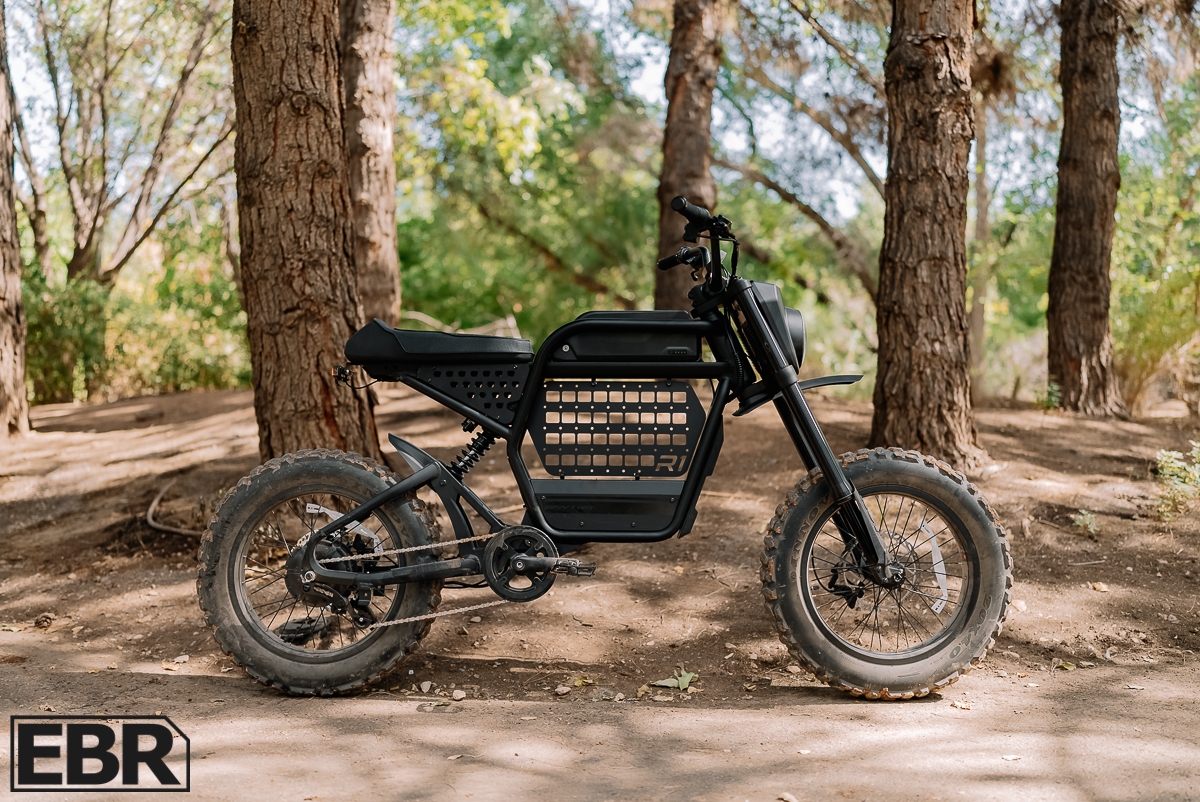
Highlights
- The 1000W Bafang motor delivers fast acceleration that’s powerful yet easy to handle for most riders.
- It aced our tests, scoring above average in braking, range, and hill climbs.
- Built for comfort, the suspension system smooths out rough rides and handles terrain like a pro.
- True to its name, it’s a solid off-roader but also shines on pavement, making it a versatile dual-duty option.
- Packed with value, it includes features like a headlight, brake light, fenders, color display, and a Molle system for carrying gear.
- The handling is dialed in, staying stable in straight lines and confident through turns, without bottoming out in ditches or rough patches.
Areas for Improvement
- The modular throttle is handy but would be better if it tied PAS levels to throttle speed for improved battery conservation.
The Ride1Up Revv 1 DRT lands as our “Best Moto/Moped Style Fat Tire E-Bike” for 2025, and it’s all about combining power, comfort, and versatility. The 1000W Bafang motor gives this bike some serious kick—fast acceleration that’s powerful but still easy to handle. Whether you’re tackling hills or cruising straightaways, it feels stable and confident, making it a blast to ride both on and off-road.
True to its name, the Revv 1 DRT is built for terrain. The suspension system keeps things smooth, soaking up bumps and handling uneven trails without drama. But don’t think it’s just an off-roader—it’s equally at home on pavement, giving you a solid dual-purpose ride. The fat tires add stability and grip, and the handling feels dialed, even when cornering or navigating ditches.
What really stands out here is the value. For the price, you’re getting premium features like a headlight, brake light, fenders, a color display, and a Molle system for carrying gear—perfect for commutes or adventures. The modular throttle is fun to use but could tie throttle speed to PAS levels for better battery management, which is a minor nitpick. Plus I was able to hit 35 MPH on the Revv 1 DRT in testing (when off-road mode is activated and check your local laws!).
If you’re after a fat-tire e-bike with moped vibes that’s as comfortable off-road as it is on city streets, the Revv 1 DRT delivers. It’s powerful, versatile, and packed with thoughtful features that make it one of the best rides in its class.
Best Fat Bike for Camping
Mokwheel Basalt
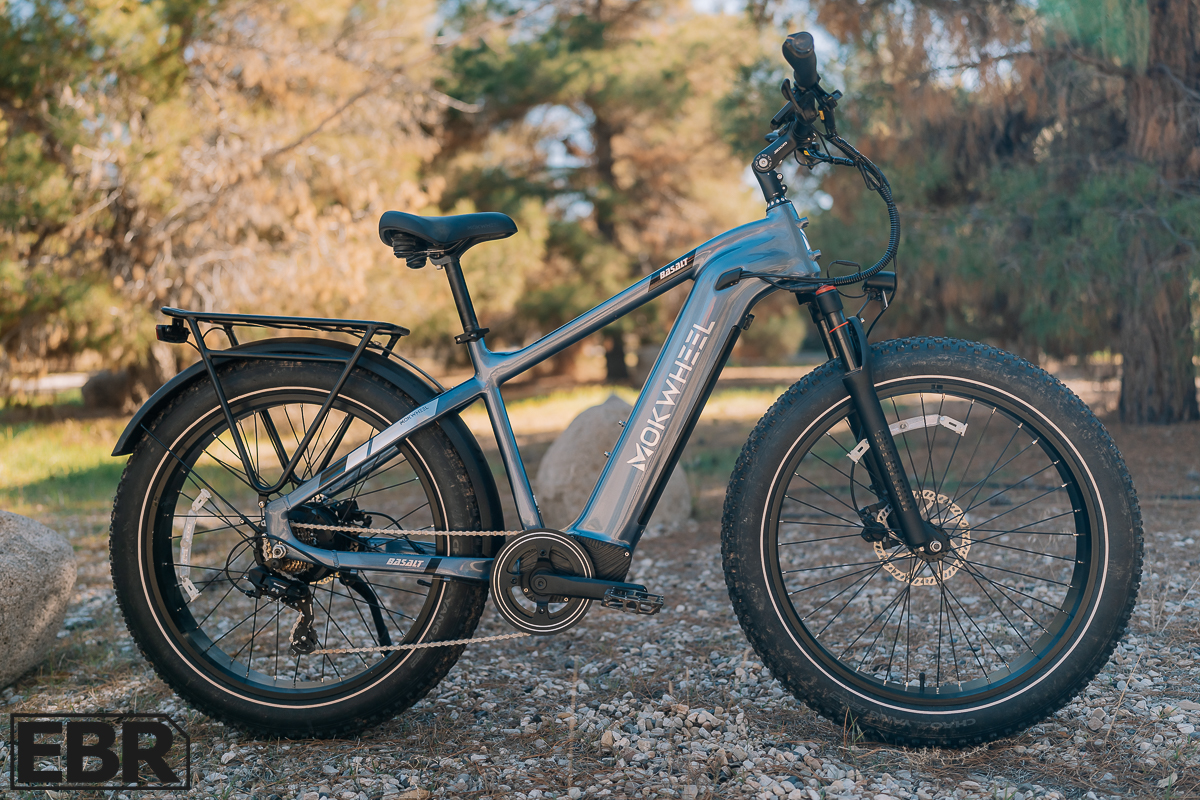
Highlights
- The 750W motor packs a punch and lets you fine-tune motor sensitivity beyond the usual 5 PAS levels.
- Optional power inverter and solar panels make this bike a solid choice for off-grid adventures.
- Adjustable stem and a wide rider height range let you dial in a fit that feels just right.
- The ride is super comfortable, thanks to the suspension, 4-inch-wide tires, and cushy contact points.
- Fat tires add confidence, giving you better stability and capability on varied terrain.
- The color display is bright, easy to read, and simple to navigate, even in direct sunlight.
Areas for Improvement
- A clutched derailleur would help reduce chain slap and keep the chain secure, especially for off-road riding.
- While braking is solid, 4-piston hydraulic disc brakes would provide extra stopping power for this 80+ lb fat-tire beast.
The Mokwheel Basalt takes the spot as the “Best Fat Tire E-Bike for Camping” on our 2025 list for its practical features and off-grid practicality. Powered by a 750W rear hub motor with 85Nm of torque, it handles steep climbs and mixed terrain with no problem. The massive 941Wh battery delivers an impressive real-world range—up to 85 miles on PAS 1. Add in the optional 1000W power inverter and foldable solar panels, and you’ve got a bike ready to keep you charged and moving off the grid.
Comfort-wise, the Basalt is dialed in for varied terrain. The 26” x 4” Chaoyang fat tires and 110mm front suspension soak up bumps, while the adjustable stem, cushioned saddle, and ergonomic grips make for a smooth, relaxed ride. Whether you’re cruising pavement or light trails, it’s comfortable enough for long days in the saddle. The 400-lb payload capacity is a bonus for carrying extra gear, groceries, or camping supplies.
The bike comes well-equipped with included fenders, a rear rack, and a clean, integrated battery design. The bright color display is easy to read, showing all the essentials like speed, assist level, and range. However, the 2-piston hydraulic brakes could use an upgrade to 4-piston calipers for better stopping power, especially given the 80+ lb weight. The Shimano Tourney 7-speed drivetrain works fine for most rides, but a clutched derailleur would reduce chain slap on rougher terrain.
At $1,599, the Mokwheel Basalt is a capable all-terrain option with the flexibility to handle camping trips, commuting, or even off-grid exploring. It’s a solid, practical e-bike for anyone who needs a reliable ride that can do a little bit of everything while keeping you connected off the grid.
Check out all the features and specs in our Mokwheel Basalt review.
Best Value Mid-Fat
Velotric Discover 1 Plus
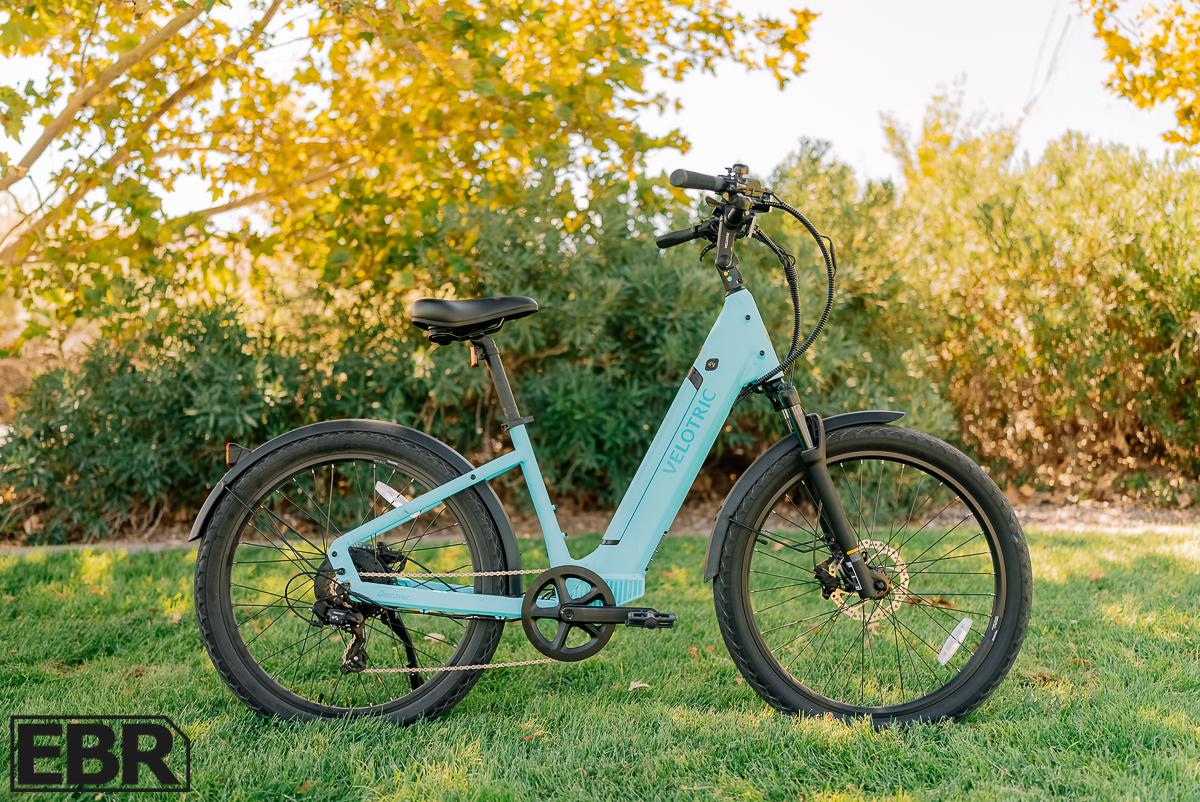
Highlights
- At $1,199, the Discover 1 Plus delivers commuter-friendly features like hydraulic disc brakes, fenders, lights, and front suspension without blowing your budget.
- The upright geometry, adjustable stem, cushy saddle, and suspension fork make for a super comfortable ride.
- Safety certifications for the battery, electronics, and durability (UL 2271, UL 2849, ISO 4210) give it some serious credibility at this price point.
- Got 69 miles on PAS 1 during testing, making it perfect for long commutes or fewer charges between rides.
- A hefty 440-lb max payload makes it great for heavier riders or carrying extra gear.
- Thoughtful commuter-ready components like a suspension fork and hydraulic brakes shine in city settings.
- Comes in 5 color options for a little extra style and personality.
Areas for Improvement
- The 11-29t cassette offers a 319% range, which can feel limited on steep climbs—more range would make hilly rides easier without over-relying on the motor.
The Velotric Discover 1 Plus earns its spot as the “Best Value Mid-Fat Tire E-Bike” for 2025, offering a reliable, commuter-friendly ride at just $1,199. Powered by a 500W rear hub motor with 900W peak output and 65Nm of torque, it delivers smooth, steady power for city commutes and light hills, with a top speed of 28 mph.
Comfort is a standout feature, thanks to its upright geometry, step-through frame, adjustable stem, and cushioned saddle. The 80mm suspension fork and 26” x 2.5” tires keep things smooth on bumpy streets, while the 691Wh battery provides an impressive real-world range of up to 69 miles on PAS 1.
Practical touches like hydraulic disc brakes, a rear rack, fenders, and five fun color options make it a commuter’s dream. While the 7-speed drivetrain’s 11-29t cassette can feel limited on steep climbs, it’s plenty for most urban terrain.
Overall, the Discover 1 Plus is a dependable, budget-friendly e-bike that combines comfort, range, and commuter-ready features in one great package.
Find everything you need to know in our Velotric Discover 1 Plus review.
Best Budget Full-Suspension Fat Bike
Mokwheel Obsidian ST
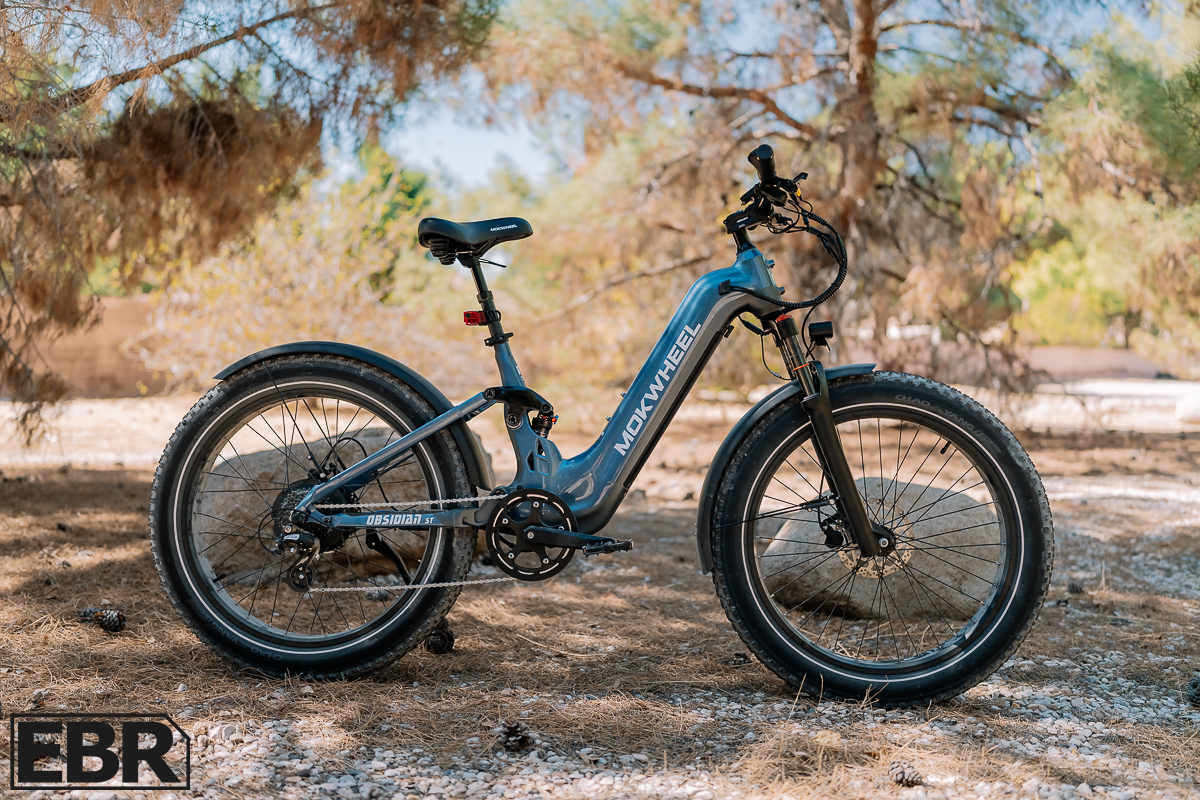
Highlights
- The motor delivers 105Nm of torque, giving it plenty of power for quick acceleration and tackling hills with ease.
- A torque sensor makes the pedal-assist feel smooth and natural, adjusting power based on how hard you pedal.
- The coil fork, rear air shock, and chunky 26×4.0” all-terrain tires make even bumpy trails feel comfortable.
- The step-through frame is easy to mount and stiff enough to avoid the flex you sometimes get with this style.
- Optional accessories like a power inverter and foldable solar panels are perfect for riders looking to go off-grid.
- A 940Wh battery provides a generous range of 60-80 miles, great for full-day adventures.
Areas for Improvement
- The Shimano Altus 8-speed drivetrain doesn’t have a clutch, which can lead to chain slap or occasional drops on rough trails.
- The rubber-strap retention band for the taillight feels flimsy and might not hold up well to sun or harsh weather conditions over time.
The Mokwheel Obsidian ST takes the win for “Best Budget Full-Suspension Fat Tire E-Bike” in 2025. With a 1000W motor and 105Nm of torque, it’s got the power to handle hills, trails, and quick takeoffs. The torque sensor makes the pedal-assist feel smooth and natural, which is rare at this price.
Comfort is dialed in with 130mm front suspension, an adjustable rear air shock, and 26×4” fat tires that soak up bumps like a champ. The step-through frame is easy to hop on and feels stiff enough to handle whatever you throw at it. Plus, the 941Wh battery delivers up to 80 miles of range—perfect for long rides or off-grid trips with the optional solar panels and power inverter.
The drivetrain could use a clutch to cut down on chain slap, and the taillight’s rubber mount feels a little flimsy, but those are small trade-offs for what you’re getting. If you’re looking for a solid full-suspension fat bike that won’t drain your wallet, the Obsidian ST is a no-brainer.
Curious about this model? Dive into our Mokwheel Obsidian ST review for all the details.
Things to Consider When Picking a Fat Tire e-Bike
Fat-tire e-bikes are built for versatility, but choosing the right one starts with two key questions: what kind of riding will you realistically do, and what’s your budget? Dreaming of epic snow-packed backroads is fun, but if most of your riding will be local trails, sandy stretches, or even daily commutes, that’s where you should focus. Narrow down your use case first—commuting, off-road adventures, or soft terrain like snow and sand—and you’ll already eliminate a ton of options.
Once you’ve got that nailed down, set your budget. Entry-level fat-tire e-bikes start around $1,400 and work well for casual riders or light-duty use. If you’re looking to tackle tougher terrain or want higher performance, mid-range bikes around $2,000-$3,000 are a solid choice. For hardcore riders needing premium components, expect to spend closer to $4,000 or more.
With those two things figured out, you can start filtering for the features that matter most. Suspension is a great example—if you’re riding mostly on smooth surfaces, a rigid fork will do the trick. Rough trails or rocky terrain? Front suspension will add comfort. Full suspension is only worth it if you’re tackling technical trails regularly.
Motors and batteries come next. If you’re dealing with hills, loose terrain, or hauling gear, a mid-drive motor with solid torque is your best bet. For flatter terrain or casual rides, a hub motor will save you some cash. Battery size depends on your ride distance and terrain, but 500Wh is a good starting point, with 700Wh or more for long or power-draining rides.
Lastly, don’t forget frame geometry and weight capacity. A relaxed geometry suits longer, more casual rides, while aggressive setups are better for technical trails. Check the bike’s weight capacity and frame size to make sure it’s a good fit for your body and gear. Once you’ve dialed in your needs, you’ll have a fat-tire e-bike that fits your riding style, budget, and terrain without overpaying for features you don’t need.
Fat-Tire E-Bike FAQ: What You Need to Know Before Buying
What’s the difference between a fat-tire e-bike, a mid-fat tire, and a regular e-bike?
The classic fat-tire e-bikes have wider tires (typically 4-5 inches) that provide better traction, stability, and float on soft or uneven terrain like snow, sand, or mud. A mid-fat bike is just a term that describes bikes with larger tires than a normal bike, but smaller than the standard 4 inches, usually they come in sizes around 2.6 to 3.5 inches. Basically, fatter tires make the bike feel more stable and generally feel much more confident going over rough terrain as opposed to a thinner tire.
Can a Fat-Tire E-Bike Legally Ride on Streets?
Yes, fat-tire e-bikes can legally ride on streets, but regulations vary based on the bike’s classification and local laws. In the U.S., e-bikes are commonly categorized into three classes:
Class 1: Pedal-assist only, with motor assistance up to 20 mph. Generally permitted on streets, bike lanes, and multi-use paths.
Class 2: Equipped with a throttle, allowing motor-powered assistance up to 20 mph without pedaling. Typically allowed on streets and bike lanes; access to multi-use paths may vary by jurisdiction.
Class 3: Pedal-assist only, with motor assistance up to 28 mph. Usually allowed on streets and bike lanes but often restricted from multi-use paths and trails.
It’s important to note that these classifications can differ by state and locality. For instance, some areas may have specific restrictions on where Class 2 and Class 3 e-bikes can operate. Additionally, certain trails or parks may prohibit e-bikes altogether.
Are fat-tire e-bikes harder to pedal?
Yes and no. The overall heavier weight coupled with well…fat tires create more rolling resistance, making them slightly harder to pedal without assistance. However, the electric motor compensates, making the ride feel smooth and manageable, even in tougher conditions.
Do I need suspension on a fat-tire e-bike?
It depends on where you’re riding. The tires themselves absorb a lot of shock, so for smooth terrain like snow, sand, or pavement, a rigid fork is fine. If you’re hitting rocky or uneven trails, front suspension or even full suspension adds comfort and control.
How far can I ride on a single charge?
Range depends on battery size (measured in watt-hours, or Wh), motor efficiency, and terrain. A 500Wh battery typically gets 25-40 miles, while a 700Wh battery can extend that to 50+ miles. Riding in sand, snow, or on hilly terrain drains the battery faster.
Are fat-tire e-bikes heavy?
Yes, they’re generally heavier than regular e-bikes due to the larger tires, reinforced frames, and powerful components. Most fat-tire e-bikes weigh between 60-80 pounds, so they’re not the easiest to carry or transport without a proper rack.
Can I ride a fat-tire e-bike in snow or sand?
That’s what they’re made for! The wide tires provide excellent float and traction on soft surfaces. Pair them with a motor that has good torque and a battery that can handle power-draining conditions, and you’re set.
Are fat-tire e-bikes good for beginners?
They can be! The wide tires provide stability and balance, making them easier to handle than narrower-tire bikes. Just be aware of the added weight and make sure to practice before tackling challenging terrain. Also, some brands let the user set speed and power limits to help them adapt at lower speeds before bumping things up a notch.
Do fat-tire e-bikes work in all weather conditions?
Yes, they’re great for all-weather use. The wider tires improve grip on wet, snowy, or muddy surfaces. However, keep an eye on your battery in extreme cold—it can reduce range significantly.
What should I look for in a fat-tire e-bike for commuting?
If commuting, prioritize lighter models, smoother tread patterns, and features like fenders, racks, and integrated lights. A motor with decent torque is still useful for inclines or hauling gear.
Are fat-tire e-bikes expensive?
Fat-tire e-bikes range in price from $1,000 for entry-level models to over $5,000 for high-end setups. Mid-range options around $2,000-$3,000 offer a good balance of quality and performance.

